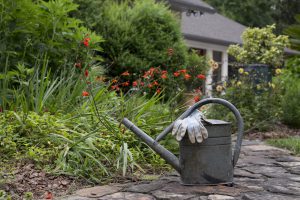Spending time gardening in the summer months can be difficult, especially in the Florida Panhandle. The brutally high temperatures and sometimes intensive humidity can make gardening seem unbearable. However, for those brave outdoor enthusiasts, there are always things to do around the homestead when it comes to vegetable gardening, landscape shrubs and lawn care.
Warm season vegetable gardening at this point becomes an uphill battle for some crops, with this being peak time for both insect and disease problems to occur. However, if you planted early enough, much of your harvest is probably in the safe zone. Scouting is key to prevent any major pest damage. Be sure to scout several times a week during these hot, summer days.
Shifting gears, the warm season is a good time to take extra special care of plants such as, azaleas and camellias, while they are establishing flower buds for the next bloom. A lack of water, fertilizer and pest detection and prevention can all certainly play a role in the following season’s flower production. Summer annuals always provide quick and easy color. Remember to feed established annuals with a complete fertilizer and remove faded blooms along the way. Water annuals well during hot, dry periods and control major annual pests to insure good production.
Finally, lawn maintenance is a need for many homeowners during this time of year. Almost all highly successful herbicides are no longer recommended at this point, as many will burn the turfgrass at temperatures above 80 degrees Fahrenheit. Depending on the weed pest and type of turfgrass, most likely the best way to control weeds in your lawn is to wait until cooler fall temperature to treat. Keeping good cultural practices this time of year will help in maintaining a healthy lawn and reduce pest pressure. Be sure to water lawns thoroughly when needed by applying one to three quarters of an inch of water weekly, depending on rainfall. Be sure to keep in mind mower height/frequency, as this is critical in keeping your lawn healthy. As stated in the “Mowing Your Florida Lawn” UF/IFAS EDIS publication, mow often enough so that no more than 1/3 of the blade height is removed per mowing. For example, if your St. Augustinegrass lawn is mowed at a height of 4 inches, it should be mowed before it grows to a height above 6 inches. It is important to always leave as much leaf surface as possible so that photosynthesis can occur, particularly in a grass that is subject to environmental or site stresses.
Unfortunately, it is chinch bug time again. Chinch bugs are prone to feed on St. Augustine lawns during hot, dry weather and may cause serious damage if not controlled. Damage usually occurs as a patch with a brown, dead center and yellowish margin. It seems chinch bugs get the blame, and often unjustly, for everything. Consult with your local county extension office to be sure the damage is not due to other reasons.
For more information, please contact your local county extension office.
Supporting information for this article can be found in the UF/IFAS EDIS publications/websites below:
Florida Vegetable Gardening Guide: https://edis.ifas.ufl.edu/publication/VH021
North Florida Gardening Calendar: https://edis.ifas.ufl.edu/publication/ep451#SECTION_7
Lawn Maintenance: https://edis.ifas.ufl.edu/entity/topic/lawn_care
Mowing Your Florida Lawn: https://edis.ifas.ufl.edu/publication/LH028
UF/IFAS Extension is an Equal Opportunity Institution.
- The Sunshine State is the Perfect Place for Sunflowers - July 20, 2025
- Why Are Sand Dunes & Sea Oats So Important? - March 20, 2025
- How to Care for a Gift Plant - December 5, 2024

